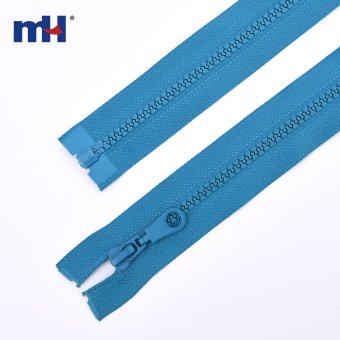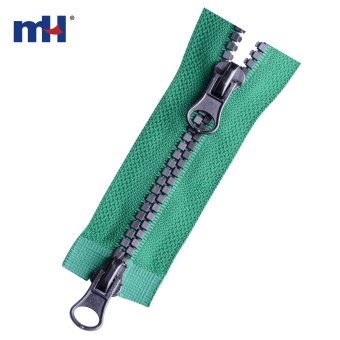Coats & Jackets
Coats and jacket zippers come in various styles and materials to suit different purposes and fashion preferences. Here are some common features of zippers used in coats and jackets, including information on materials, zipper end types, slider mechanisms, etc.:
- Teeth Material: Coats and jackets often require zippers that can withstand frequent use and exposure to the elements. Therefore, the zippers used are typically made of durable materials like metal or high-quality plastic.
- Metal zippers are durable, heavy-duty, and are suitable for most types of coats and jackets, especially those made from heavy fabrics like leather or denim.
- Plastic zippers can be a good choice for lightweight jackets, raincoats, or when a more casual look is desired. They are not as strong as metal zippers but are more corrosion-resistant.
- Teeth Size: For coats and jackets, choose a zipper with sturdy, medium to heavy-duty teeth that can withstand the weight and movement of the garment.
- Tape Material: Consider the tape material, which can be made of cotton, polyester, or other materials. Polyester tape is often preferred for its strength and durability.
- Separating End/Open End: Coats and jackets typically use separating zippers, also known as open-ended zippers. These zippers can be fully separated at the bottom, allowing for easy on/off and ventilation.
- Two-Way Zipper: Many coats and jackets feature two-way zipper. This allows you to unzip the jacket from both the top and bottom, providing ventilation and ease of movement, especially in longer coats or parkas.
- Auto Locking Slider: Many jacket zippers have auto locking sliders that prevent the zipper from accidentally opening, adding extra security and wind resistance.
- Water Resistance: Zippers for coats and jackets often have water-resistant or waterproof features to keep the wearer dry in wet conditions. This is achieved through specially designed sliders or zipper tape coatings that prevent moisture from penetrating the zipper teeth.
-
Zipper Width and Length:
- Measure the length of the existing zipper or the opening you need to zip. Ensure the zipper is slightly longer than the opening to allow for easy attachment and use.
- Consider the width of the zipper tape (the fabric strip on which the zipper teeth are attached) as well. Wider tape can provide extra durability.
Zipper Size Chart
| Zipper No. | Size | Application |
| 1 – 4 | Small | Skirts, trousers, cushions, clutch bags, dresses, purses |
| 5 – 7 | Medium | Jackets, tents, sleeping bags, boots, golf bags |
| 8 – 10 | Large | Wetsuits, upholstery, heavy-duty clothing, boat covers |
Application



